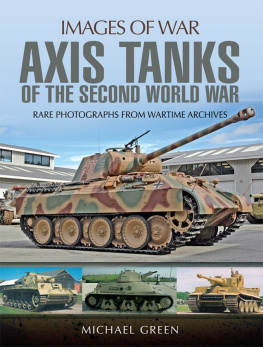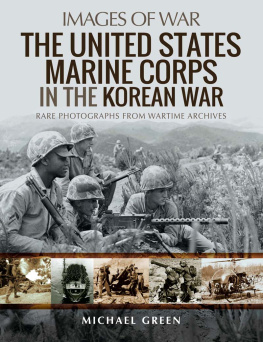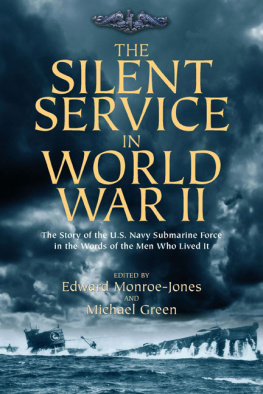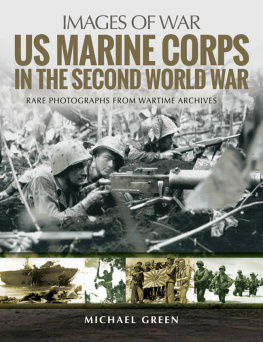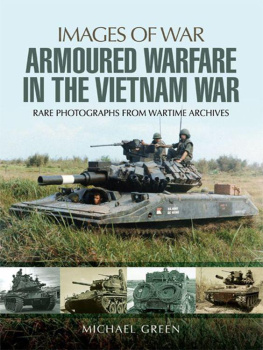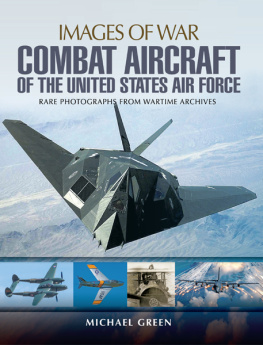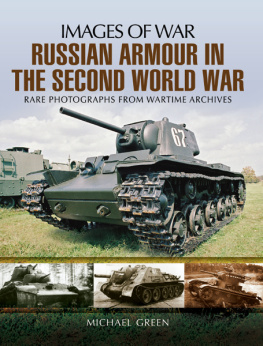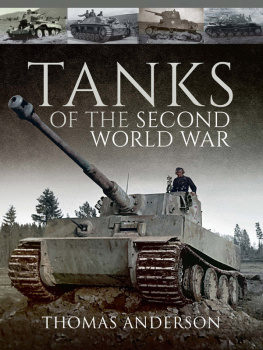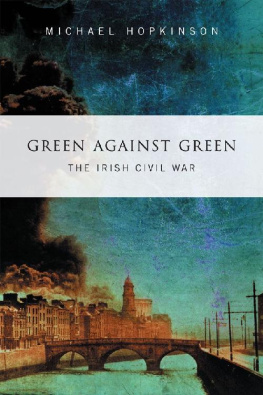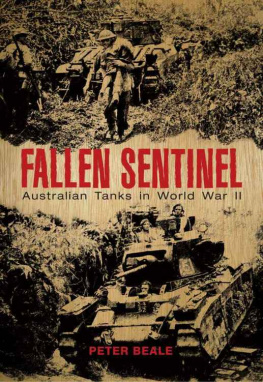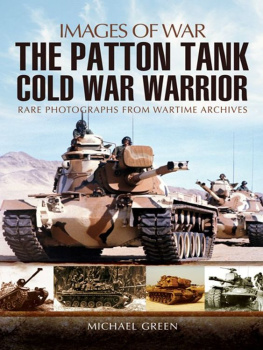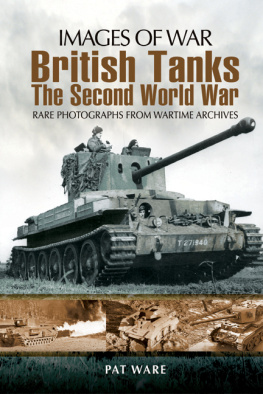Michael Green - Axis Tanks of the Second World War
Here you can read online Michael Green - Axis Tanks of the Second World War full text of the book (entire story) in english for free. Download pdf and epub, get meaning, cover and reviews about this ebook. year: 2017, publisher: Pen & Sword Books, genre: Science fiction. Description of the work, (preface) as well as reviews are available. Best literature library LitArk.com created for fans of good reading and offers a wide selection of genres:
Romance novel
Science fiction
Adventure
Detective
Science
History
Home and family
Prose
Art
Politics
Computer
Non-fiction
Religion
Business
Children
Humor
Choose a favorite category and find really read worthwhile books. Enjoy immersion in the world of imagination, feel the emotions of the characters or learn something new for yourself, make an fascinating discovery.
- Book:Axis Tanks of the Second World War
- Author:
- Publisher:Pen & Sword Books
- Genre:
- Year:2017
- Rating:4 / 5
- Favourites:Add to favourites
- Your mark:
- 80
- 1
- 2
- 3
- 4
- 5
Axis Tanks of the Second World War: summary, description and annotation
We offer to read an annotation, description, summary or preface (depends on what the author of the book "Axis Tanks of the Second World War" wrote himself). If you haven't found the necessary information about the book — write in the comments, we will try to find it.
Axis Tanks of the Second World War — read online for free the complete book (whole text) full work
Below is the text of the book, divided by pages. System saving the place of the last page read, allows you to conveniently read the book "Axis Tanks of the Second World War" online for free, without having to search again every time where you left off. Put a bookmark, and you can go to the page where you finished reading at any time.
Font size:
Interval:
Bookmark:

RARE PHOTOGRAPHS FROM WARTIME ARCHIVES
Michael Green
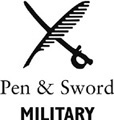
First published in Great Britain in 2017 by
PEN & SWORD MILITARY
An imprint of
Pen & Sword Books Ltd
47 Church Street
Barnsley
South Yorkshire
S70 2AS
Copyright Michael Green, 2017
ISBN 978-1-47388-700-8
eISBN 978-1-47388-702-2
Mobi ISBN 978-1-47388-701-5
The right of Michael Green to be identified as author of this work has been asserted by him in accordance with the Copyright, Designs and Patents Act 1988.
A CIP catalogue record for this book is available from the British Library.
All rights reserved. No part of this book may be reproduced or transmitted in any form or by any means, electronic or mechanical including photocopying, recording or by any information storage and retrieval system, without permission from the Publisher in writing.
Pen & Sword Books Ltd incorporates the imprints of Pen & Sword Archaeology, Atlas, Aviation, Battleground, Discovery, Family History, History, Maritime, Military, Naval, Politics, Railways, Select, Social History, Transport, True Crime, and Claymore Press, Frontline Books, Leo Cooper, Praetorian Press, Remember When, Seaforth Publishing and Wharncliffe.
For a complete list of Pen & Sword titles please contact
PEN & SWORD BOOKS LIMITED
47 Church Street, Barnsley, South Yorkshire S70 2AS, England
E-mail:
Website: www.pen-and-sword.co.uk
The author would like to dedicate this book to fellow tank buff Ian Wilcox for all his help with this title and others.
M ichael Greens comparative study of Axis tanks demonstrates well the unique military situations of the three largest nations starting the Second World War. Germany, Japan and Italy had conducted their rearmament programmes in advance of their opponents and enjoyed certain advantages for a limited period of time. However, upon closer examination each encountered fatal weaknesses, even though the war continued for several years.
Japan and Italy both began their rearmament programmes early in the 1930s, and the development of their respective tank arms demonstrated a great deal of progress over the crude tanks of the First World War. In particular, lighter and handier machines with modern diesel and gasoline engines incorporating automotive advances in suspensions and more effective weapons served very well in the incipient warfare of the 1930s. However, the costs of the wars of the 1930s inhibited further progress to a considerable extent.
Italian forces participated in General Francos eventual victory of his Nationalist forces in the Spanish Civil War. Hundreds of light tanks, armoured cars and aircraft were sent with their own forces and most of the equipment was lost, worn out or left behind for the use of their Spanish compatriots. On the ground, Italian forces eventually demonstrated a form of mechanized warfare novel for the time, emphasizing mass and rapid movements to exploit enemy dispositions and affect a pursuit. Although doctrine and organization for their armoured division showed evident promise, the general staff did not allocate resources for the medium and heavy tanks it required and in 1940 most armoured units were of the paper form.
Japanese tanks proved useful in their expansion into China, and in the opening months of the Pacific War, the Japanese army put them into operation in their rapid conquest of Dutch and British colonies. Frequently they appeared in campaigns where the Allies had judged armour unsuitable for employment, much to their surprise and demise. On the other hand, the brief combat encounters with tanks of the Soviet Union during border conflicts in Manchuria demonstrated that Japanese armour remained demonstrably inferior.
In the end, only Germany of all the Axis powers had the economic, industrial and technological bases for advanced tank development. Despite its limited experimentation with tanks before the Nazi seizure of power, the German army had sound doctrine for manoeuvre warfare using motorized troops, and German industry overcame initial handicaps to begin production of two medium tank designs by 1938 that greatly facilitated success in battle in the opening years of the war. Ironically, these tanks displayed neither the best armament nor armour nor speed among their contemporaries. However, what they did incorporate in their designs proved decisive: a three-man turret and a radio. They also were of sufficient size that their weapons and armour could be augmented as the gun/armour race of the war evolved.
The German tankers of 194041 encountered tough opponents in those years mounted in British Matilda, French Char B or Russian T-34 tanks. They managed to outfight them thanks to superior organization and tactics, aided by the fact that the vehicle commander had no duties serving the gun and he had radio contact with all his tanks and his higher commander.
By the end of 1942, however, the Axis reached the limits of their initial advantages and no new tanks, be they Panthers or Tigers, could counter the crushing superiority of the three major Allied powers that caught up with and surpassed them in technology and organization.
Kenneth W. Estes, PhD.
Lieutenant Colonel, US Marine Corps
Author, Marines Under Armor
A s with any published work, authors must depend on a great many people for assistance. These included, over many years, my fellow author and long-time mentor the late Richard Hunnicutt. Other friends who kindly supplied pictures for this work are credited in the captions.
Both the paid and volunteer staff of the now-closed Patton Museum of Armor and Cavalry provided the author with a great deal of assistance over many years. For the sake of brevity all images from the former Patton Museum of Cavalry and Armor will be credited to the Patton Museum.
I am also indebted to David Fletcher, fellow author and the long-time former librarian at the Tank Museum located in Bovington, England. He has greatly assisted the author in locating photographs for many of his books. All images from the Tank Museum in Bovington will be credited to just the Tank Museum for brevity.
Due to the size and format restrictions imposed by the publisher on this series of books the author will concentrate on the gun tank versions of the vehicles described in the text. Those tanks converted to support-based versions such as self-propelled artillery or anti-aircraft vehicles will be covered in a subsequent title.
Prior to the Second World War and during the conflict armies generally classified their tanks as light, medium or heavy, based on the weight of the tank. The weight classifications of what constituted the breakdown between the different types of tank varied from one country to another, with one armys heavy tank being anothers medium tank, for example.
The quality of some images in this book is rather substandard. However, they have been included due to the historical rarity of the subject pictured.
Both the Waffen SS and the Luftwaffe field divisions employed tanks during the Second World War. For the sake of brevity the author will put these under the umbrella term of German army in this work.
I n the 1920s, the German army began thinking about the need for tanks. Undecided at that time was whether light or medium tanks were a better choice. Some thought that large numbers of small and cheap light tanks could overwhelm an opposing enemy by sheer force of numbers. In 1930 a German army officer wrote that the proposed light tanks should be supported in battle by a smaller number of better-armed and armoured medium tanks.
Next pageFont size:
Interval:
Bookmark:
Similar books «Axis Tanks of the Second World War»
Look at similar books to Axis Tanks of the Second World War. We have selected literature similar in name and meaning in the hope of providing readers with more options to find new, interesting, not yet read works.
Discussion, reviews of the book Axis Tanks of the Second World War and just readers' own opinions. Leave your comments, write what you think about the work, its meaning or the main characters. Specify what exactly you liked and what you didn't like, and why you think so.

